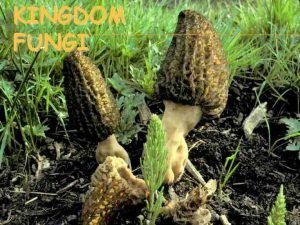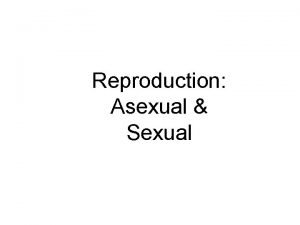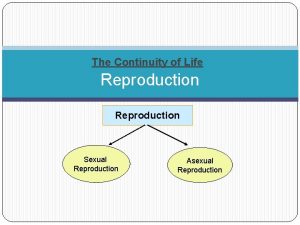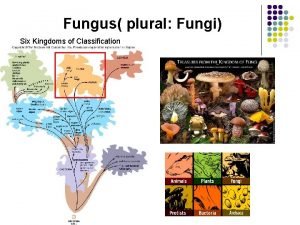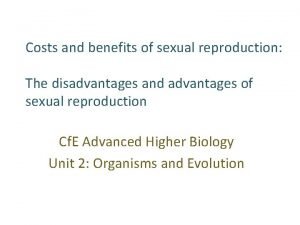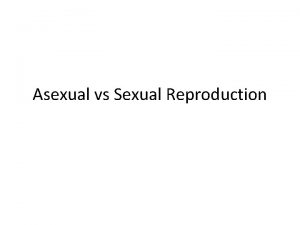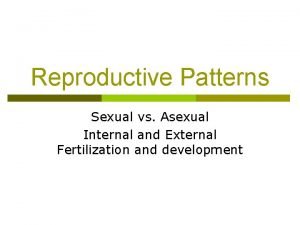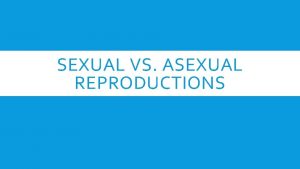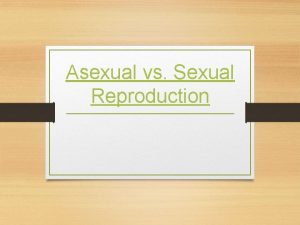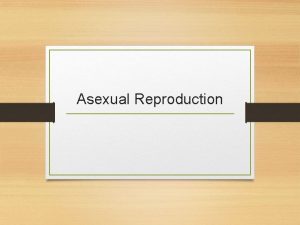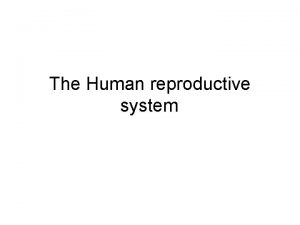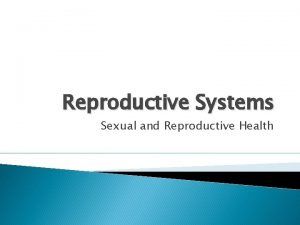Reproductive Strategies Asexual vs Sexual External vs Internal











- Slides: 11

Reproductive Strategies Asexual vs. Sexual External vs. Internal Fertilization Spores vs. Seeds in Plants Egg Types

Asexual vs. Sexual Reproduction Asexual Sexual More opportunities Less energy needed More offspring Less offspring No parental care Some parental care Lower offspring survival Higher offspring survival

Asexual Reproduction

Sexual Fertilization

External vs. Internal Fertilization (uniting of sperm and egg) External(outside) Internal(inside) Needs a water environment Doesn’t require a water environment Eggs are unprotected Eggs are protected (uterus or shell) Random/inaccurate fertilization Specific/accurate fertilization Large amounts of sperm/egg Small amounts of sperm/egg Typically aquatic animals (fish, amphibians) Typically land animals (reptiles, birds, mammals)

Spores vs. Seeds in Plants Spores Seeds Microscopic size Large and visible Simple single-celled structure Complex multi-celled structure Produced by leaves Produced by flowers/fruit Needs water to germinate Can germinate anywhere Spread by wind Spread by animals, wind, & water Produced in large amounts Produced in lesser amounts

Spores vs. Seeds in Plants

Spores

Types of Seeds

Egg types of Vertebrate Animals Fish & Amphibian Eggs -no shell -embryonic sac provides nutrients -needs water to survive Amniotic Egg -yolk sac provides nutrients -shell protects embryo -Reptiles(soft) & Birds(hard) - survives dry land

Egg types of Vertebrate Animals Placental Mammals -no shell -placenta provides nutrients -internal development
 Basidiomycota characteristics
Basidiomycota characteristics Sexual and asexual reproduction venn diagram
Sexual and asexual reproduction venn diagram Sexual and asexual reproduction venn diagram
Sexual and asexual reproduction venn diagram Two types of reproduction
Two types of reproduction Asexual vs sexual reproduction
Asexual vs sexual reproduction Chromosomes in organisms
Chromosomes in organisms Venn diagram asexual and sexual reproduction
Venn diagram asexual and sexual reproduction Sexual or asexual reproduction
Sexual or asexual reproduction Asexualk
Asexualk Coenocytic
Coenocytic Disadvantage of sexual reproduction
Disadvantage of sexual reproduction Sexual or asexual reproduction
Sexual or asexual reproduction
